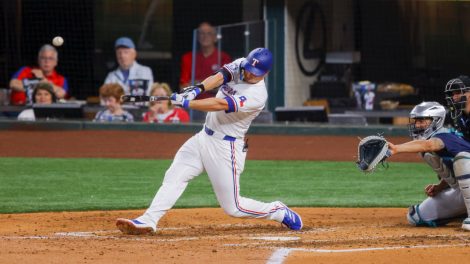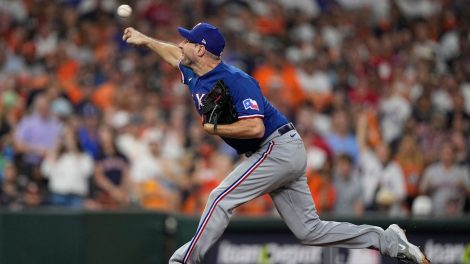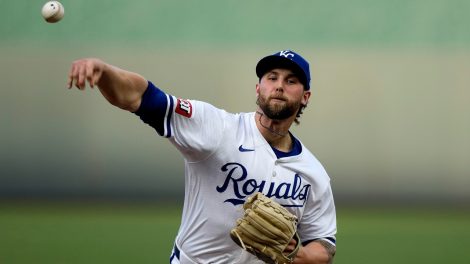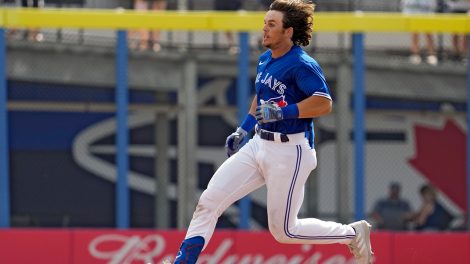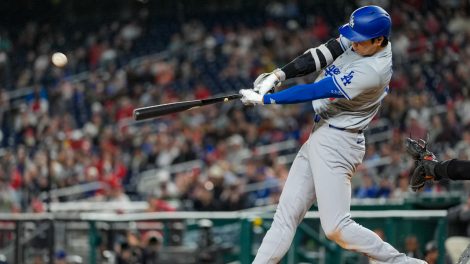DUNEDIN, Fla. — This past off-season was an unusual one for Thomas Hatch. He barely opened a textbook.
Last winter, he was on campus at Oklahoma State University, where he pitched for two seasons before he was selected by the Chicago Cubs in the third round of the 2016 Draft. When he left Oklahoma, he was still a few semesters away from finishing his degree, majoring in finance and minoring in accounting. And Hatch, now a right-handed pitching prospect in the Toronto Blue Jays organization, isn’t the type to put things off.
“I knew I wanted to finish it up — and I figured the earlier I did it, the easier it would be,” he said, standing at his locker in the Blue Jays’ Dunedin clubhouse, now the proud owner of that degree. “It was kind of weird being on campus because I was so old. But, at the same time, I guess it made me feel young.
Hatch is 25. That is objectively young. But in 2019 more than 200 pitchers 25 or younger made MLB appearances and Hatch wasn’t one of them. So, it’s all relative. And if Hatch has his way, he won’t turn 26 without getting there himself.
“That’s the plan — make my debut this season and go from there,” said Hatch, who Thursday pitched a clean inning on 10 pitches, eight of them strikes, three of them swinging. “If I can continue where I left off last year, I think I have a decent shot.”
There is some nuance in that. Last season, Hatch pitched to a 4.12 ERA over 27 double-A starts, a figure that doesn’t seem that impressive at face value but also doesn’t tell the entire story. Over his final 11 starts of the season — five prior to being traded to the Blue Jays at the deadline for major-league reliever David Phelps and six after — Hatch put up a 2.72 ERA with 8.5 K/9 and 1.9 BB/9, holding opposition batters to a .210/.263/.344 batting line.
Thomas Hatch in 2019
| GS | IP | ERA | BB/9 | OPS | |
|---|---|---|---|---|---|
| April – June | 16 | 79 | 5.13 | 3.1 | 0.845 |
| July – August | 11 | 56.1 | 2.72 | 1.9 | 0.607 |
So, what happened? Well, for starters he got healthy. Hatch pitched through shoulder inflammation for the first three months of his season, which caused severe command issues, upping his walk totals and forcing him to work frequently with runners on base.
Hatch isn’t sure exactly why his shoulder started bothering him, only that it grew nearly unbearable by the middle of the season. He was backed off for a spell in July, missing a couple starts in favour of undergoing a rehab program. His workload was closely managed upon his return, and he threw only 8.1 innings from July 14 through the end of the month.
[snippet id=4863988]
It was a frustrating period, but the plan ultimately worked. Hatch finally got over the issue right before he was traded and started to regain confidence in his command. Then, upon joining the Blue Jays, his new organization presented him with a detailed analysis of his pitch usage and how he could leverage his repertoire more effectively. Hatch’s new double-A pitching coach Vince Horsman — who’s no longer with the organization — really liked one of those pitches in particular.
“He identified my change-up right away,” Hatch said. “He said, ‘You know, that’s a pretty good pitch.’”
To that point, Hatch had relied heavily on a low-to-mid 90’s sinker, paired with a slider he could manipulate to make smaller and more cutter-ish when he wanted called strikes or bigger with more depth when he wanted swing-and-miss. But he seldom used his change-up and the Blue Jays couldn’t figure out why. For one reason or another, the Cubs didn’t emphasize the pitch. But the Blue Jays thought it was better than Hatch was being given credit for.
Hatch agreed. He always thought his change-up was one of his better pitches, featuring sharp, downward, splitter-like action rather than the more common, fading change-up many pitchers throw. But he got away from it in college because his breaking ball worked so well against swing-happy hitters. He started reincorporating it when he turned professional, but then the Cubs dissuaded him from using it.
[snippet id=3305549]
The Blue Jays were the complete opposite. They wanted Hatch to use it more and more, tunnelling it off of his high-spin fastball down in the zone. The idea is the change-up looks like Hatch’s fastball out of his hand, before dropping down into the dirt to generate swing-and-miss. Of course, Hatch’s fastball command down is crucial to that. Which is why it was so important for him to finally get over his shoulder issue.
“Being healthy and being able to put the ball where I wanted helped a lot,” he said. “And the staff with the Blue Jays were great with the way they handled me, and the way they recommended using my pitches. The Blue Jays had an environment where I could use the stuff that I thought would work. And it ended up working.”
Healthy and throwing his change-up early and often, Hatch rattled off a series of stellar outings for the New Hampshire Fisher Cats throughout August, posting a 2.80 ERA in the month. His final two outings of the season were spectacular, as he followed up a seven-inning shutout with a seven-inning, two-run, 11-strikeout effort. He walked only two batters over his 35.1 innings that month, striking out 34.
It’s that performance that encouraged the Blue Jays to add Hatch to their 40-man roster in November, lest he be exposed to the Rule 5 draft and potentially poached by another organization. Now he’s in big-league camp with his new team, continuing to hone that change-up and think about smarter ways to play it off his fastball and slider. And sometime before his 26th birthday in September, there’s a strong chance he’ll make a long-awaited MLB debut.
Which gets us back to those finance textbooks. With his education completed, Hatch was able to spend his entire winter focusing on preparing for the season without distractions.
One theory Hatch has for the shoulder issues he experienced in 2019 is that he started ramping up his throwing too late, due in part to the time he was spending at Oklahoma finishing his degree. He began his throwing program in January that year. This off-season, he started in early November, progressing much more slowly than he has in winters past while working through a comprehensive off-season strength and conditioning regiment for the first time in his career.
“I think that’s helped a lot, because I feel great,” Hatch said. “It’s just the feel you gain as you have more seasons under your belt. I feel really good. I’m more advanced at this stage of spring than I have been in years past.
“I focused on arm care throughout the off-season. Strengthening the shoulder. Sometimes you get lost in school and sometimes it’s put on the back burner. So, that was a big step in how my arm feels right now, I think.”
So, this isn’t to say don’t stay in school. You should. And for Hatch, whose parents are both accountants, there was little choice. But a step back from his studies could pay very real dividends for the Blue Jays right-hander. He’s obviously happy he completed his degree. But he’ll be even happier if he can follow it up with a long MLB career.
“Finishing the degree was a big relief more than anything,” he said. “I haven’t really thought about how I might use it eventually. I haven’t thought that far ahead. Hey, maybe I won’t have to.”
[relatedlinks]



